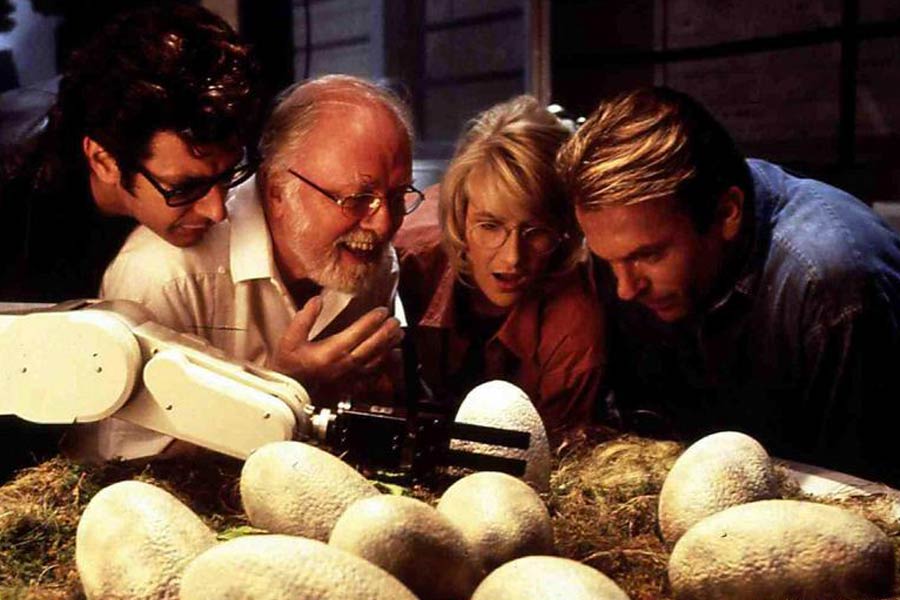In 1993, director Steven Spielberg's "Jurassic Park" depicted the disastrous consequences when humans resurrected long-extinct dinosaurs for a theme park. The reptiles eventually ran riot, leaving their ill-equipped creators either dead or ruing their gamble of playing God.
Released in the United States on June 11, 1993, "Jurassic Park" made cinematic history as the first film to integrate CGI technology and animatronic figures into live action scenes.
The result? Dinosaurs ended up appearing as "real" as any other species featured in a regular nature documentary. Up-close, they had leathery skin, with veins and sinews visible; they breathed, lumbered, lunged or roared so convincingly, one forgot that they were computer-generated or hand-built.
The film grossed over $914 million worldwide in its original cinematic run, becoming the highest-grossing film ever at the time, surpassing Spielberg's previous blockbuster, 1982's "E.T. The Extra-Terrestrial."
Gripping premise
At its core, "Jurassic Park" made us wonder: "What if?"
Based on the 1990 novel of the same name by bestselling author Michael Crichton — who also co-wrote the film's screenplay — the story is set on the fictional island of Isla Nublar, located off the west coast of Costa Rica. There, wealthy industrialist John Hammond (played by Richard Attenborough) and a team of genetic scientists create an amusement park of dinosaurs cloned through genetic engineering.
Requiring a safety certification after a velociraptor kills its handler, Hammond invites paleontologist Alan Grant (Sam Neill), paleobotanist Ellie Sattler (Laura Dern) and chaotician Ian Malcolm (Jeff Goldblum) to the park hoping that they'll okay his plans to open it to the public. Hammond's grandchildren, Tim and his sister Lex, (Joseph Mazzello and Ariana Richards) complete the group.
Having only worked with the beasts' fossils up until then, Grant and Sattler get caught up in the euphoria of seeing dinosaurs fleshed out and roaming the park. Skeptical Malcolm, however, questions this potentially disastrous artificial disruption of the existing natural order.
"Jurassic Park is a place where the dinosaurs are knocking out a living for themselves. And they simply regard man as a sort of cohabitant to either coexist with peacefully or to be pursued as prey," Steven Spielberg told "Empire Magazine" in August 1993.
Master of suspense and thrills
Steven Spielberg had long made filmmaking history for helming Hollywood's first summer blockbuster: "Jaws" in 1975.
Who can forget the great white shark's stealthy approach underwater accompanied by composer John Williams' ominous "dum dum, dum dum" score?
Many (this writer included) still blame that mechanical shark for their fear of water.
Spielberg's ability to keep audiences at the edge of their seats is evident in his vast and varied filmography. "Jurassic Park" was no different, boasting its own heart-in-mouth moments.
One of the simplest, yet most impactful scenes featured Hammond's grandchildren Tim and Lex, sitting in a stalled jeep waiting to be rescued. They notice the water in the drinking glasses on the car's dashboard rippling, which is timed perfectly with heavy thudding in the background that steadily grows in volume and intensity before the T-Rex makes its grand entrance — with a grisly end for some.
Another startling scene: The spitting Dilophosaurus. One minute, it's a cute yet curious dinosaur; the next, it's viciously spewing acid at its victim with frills unfurled.
Jaw-dropping technology
Although "Jurassic Park" unleashed dino-mania worldwide, it was not the first flick featuring the massive reptiles, whose 180-million-year reign was snuffed out almost overnight after an asteroid hit earth 66 million years ago.
Older dinosaur films used stop-motion, go-motion, prosthetics, animatronics, and other traditional methods. However, sometimes the dinosaurs' movements onscreen appeared 'jerky' — reminding viewers they weren't real.
"Jurassic Park" was not the first film to use computer-generated imagery (CGI). It was also used successfully in "Tron" (1982) and "Terminator 2: Judgment Day" (1991), and to a certain extent, in 1977's "Star Wars."
However, by the time Spielberg breathed life into Michael Crichton's story, CGI was more advanced and the director's visionary decision to harness and combine it with other traditional methods led to a previously unimagined shift in filmmaking. Today, everything we read in books or simply imagine could potentially be realized onscreen.
Pause for thought
Another part of the allure of "Jurassic Park" is its pithy dialogues. Jeff Goldblum's Dr. Ian Malcolm had perhaps some of the best lines in the film.
One scene features the visitors waiting to see the T-Rex in its enclosure for the first time. Trying to wrap his head around this prospect, Dr. Malcom muses: "God creates dinosaurs, God destroys dinosaurs. God creates Man, man destroys God. Man creates dinosaurs."
To which Dr. Ellie Sattler (Laura Dern) interjects, "Dinosaurs eat man...Woman inherits the earth."
There was also a cheeky reference to a theme park ride — long before it inspired another successful film franchise itself.
When John Hammond cites Disneyland as an example of theme parks experiencing hiccups when they first open, Malcolm wryly retorts, "If 'The Pirates of the Caribbean' breaks down, the pirates don't eat the tourists."
Still thrilling after 30 years
Five sequels have since followed and with a worldwide gross of $6 billion, "Jurassic Park" is one of the most profitable franchises of all time and in the history of cinema.
And while one would think that technological advancements would add value to its sequels, purists and dino fans alike swear by Spielberg's maiden "Jurassic Park" film.
It is no wonder the Library of Congress selected the film in 2018 for preservation in the United States National Film Registry for being "culturally, historically, or aesthetically significant."
30 years on, "Jurassic Park" remains in a class of its own, if anything for bringing dinosaurs to life in front of our very eyes.










